Pigs have become one of the most important livestock in human lives. Most people breed pigs for their meats while others might raise them as pets.
There are certain misconceptions that pigs only come in solid colors like black, white, pink, or brown. In fact, some people believe that most farmed pigs are pink. But this is far from the truth.
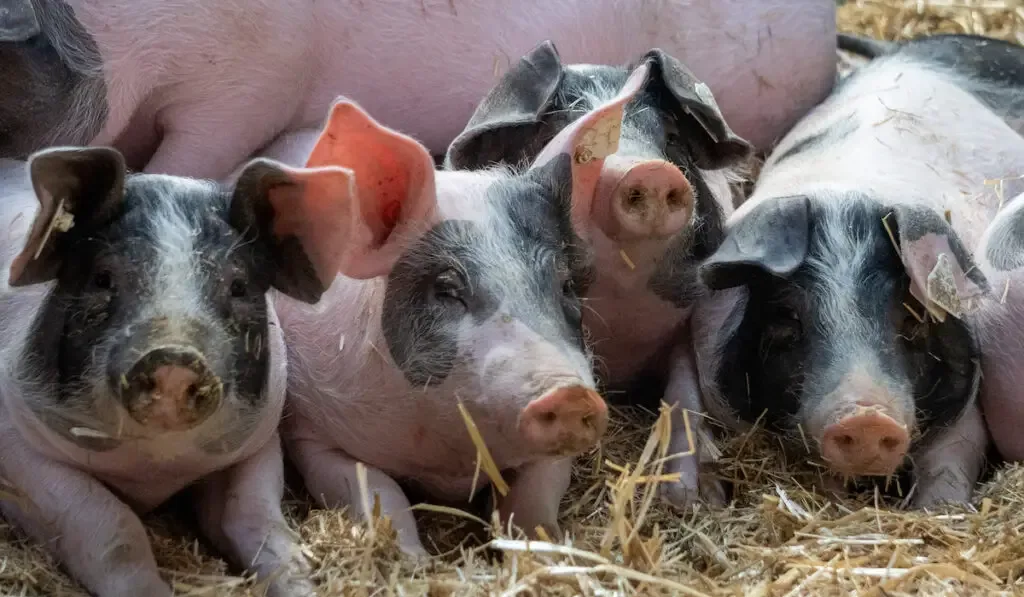
Pigs’ skin is mostly pink or whitish-pink in color. But when a mutation occurs, their skin stops producing or overproducing melanin and eumelanin, resulting in different coat colors.
In some breeds, two or three mutations occur in their body, causing different coloration on their skin. This is where black and white pig breeds come from. They are what we called spotted pigs.
With that said, here are 19 black and white pig breeds.
1. Angeln Saddleback

Also known as the Angler Sattelschwein, these pigs are a rare breed of domestic pigs that can be widely found in Schleswig-Holstein, Germany. They were developed by crossing a local German black and white Landrace pig with the Wessex Saddleback.
At maturity, they are 33 to 36 inches tall and weigh around 661 to 771 pounds.
Angeln Saddlebacks can be recognized by their large, looped ears, and a white band around their large bodies. They are docile and hardy breeds and can adapt to harsh climates and environments.
The mothers produce a great amount of milk for their piglets. Being omnivorous, they typically eat leaves, seeds, fungus, roots, and occasionally some meats.
2. Aksai Black Pied
Aksai Black Pied are medium to large-sized pigs that originated from Kazakhstan. They were first developed in 1952 by crossing the native pigs with the Berkshires and the Large Whistles then crossed again with Large White, Landrace, and North Caucasian pigs for commercial purposes.
At maturity, they are 66 to 72 inches tall and weigh around 530 to 710 pounds.
These stocky pigs can be recognized by their erect ears, big, long bodies, big muzzles, and strong legs. They have uneven black patches on their white or dark gray bodies. Being bred mainly for meat production and agricultural purposes, Aksai Black Pied are docile and easy to handle.
Due to their large body size, these pigs produce a great amount of high-quality meat.
3. Ba Xuyen
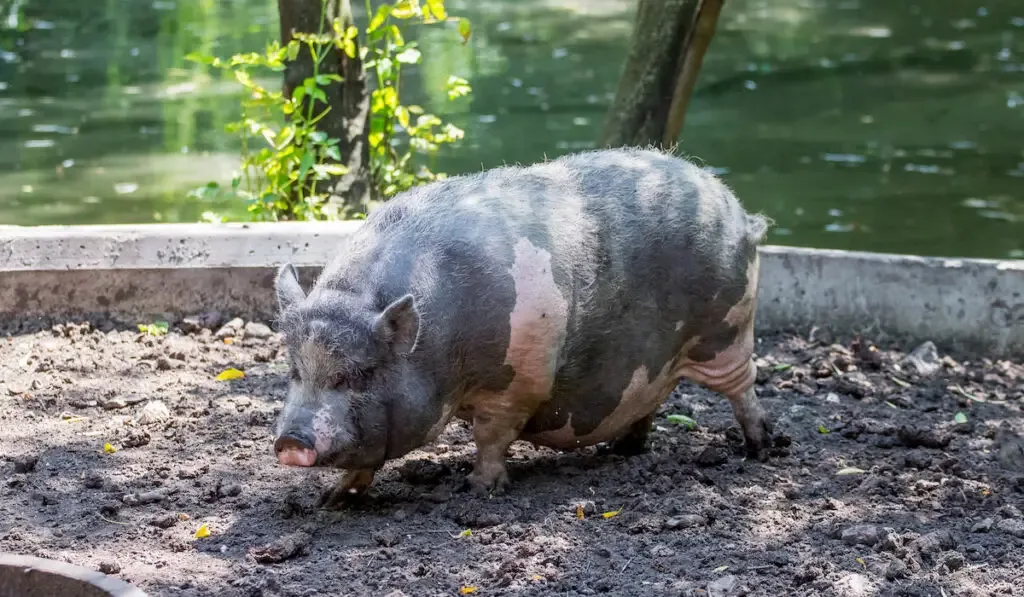
Originated from southern Vietnam, specifically along the Mekong River delta, these small to medium-sized pigs were developed from a cross between Berkshire pigs and Bo Xu pigs.
At maturity, they are 25 to 28 inches tall and weigh around 220 pounds. As domesticated pigs, these pigs are intelligent, docile, and well-adapted to the salt-water environment in southern Vietnam.
Ba Xuyens have a short face and legs, medium-sized ears, curved snout, twisted tails, and uneven black patches on their white to pinkish bodies. Their diet mainly consists of rice, grains, and fodders. Unlike other pigs, Ba Xuyens are resilient to most diseases and can live up to 12 years.
They are raised mainly for their meat.
4. Belarus Black Pied
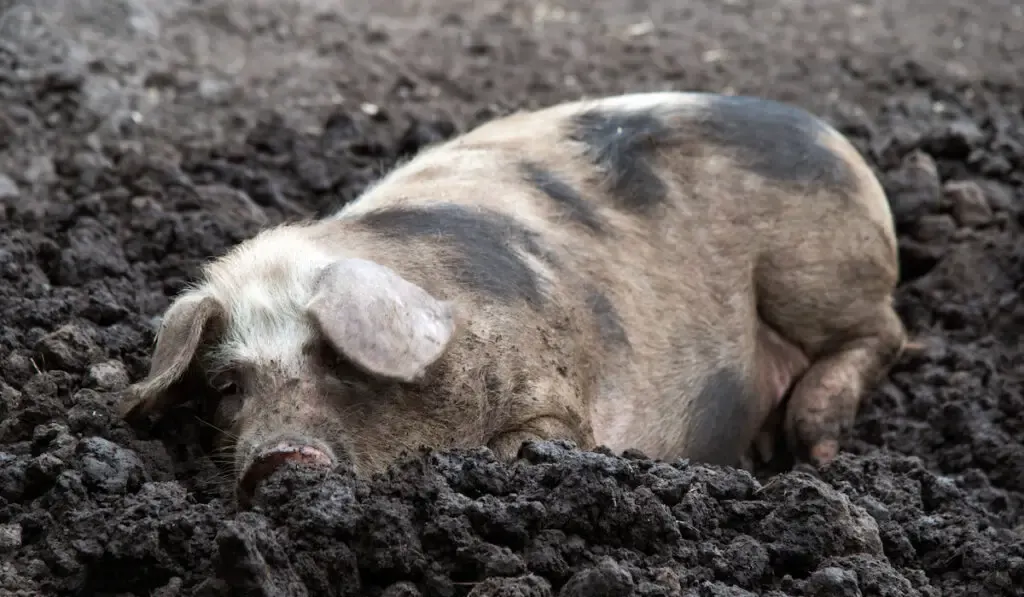
Belarus Black Pied pigs are native to Minsk, Belarus. They are also called the White-Russian Black Pied, the Byelorussian Black Pied, and the Spotted Black Pied.
These pigs were developed in the late 19th century by crossing a few different breeds including Large White, Large Black, Berkshire, and Middle White.
At maturity, they are 28 to 30 inches tall and weigh around 536 to 657 pounds. Usually, the boars are heavier than the sows.
These multipurpose pigs have straight heads, medium-sized pink snouts, wide bodies, twisted tails, and irregular black patches on their face and back.
They are omnivores and mainly feed on leaves, plants, grasses, fruits, flowers, and animal meat. Farmers and breeders raise these pigs mainly for their meat and lard production.
5. Bentheim Black Pied
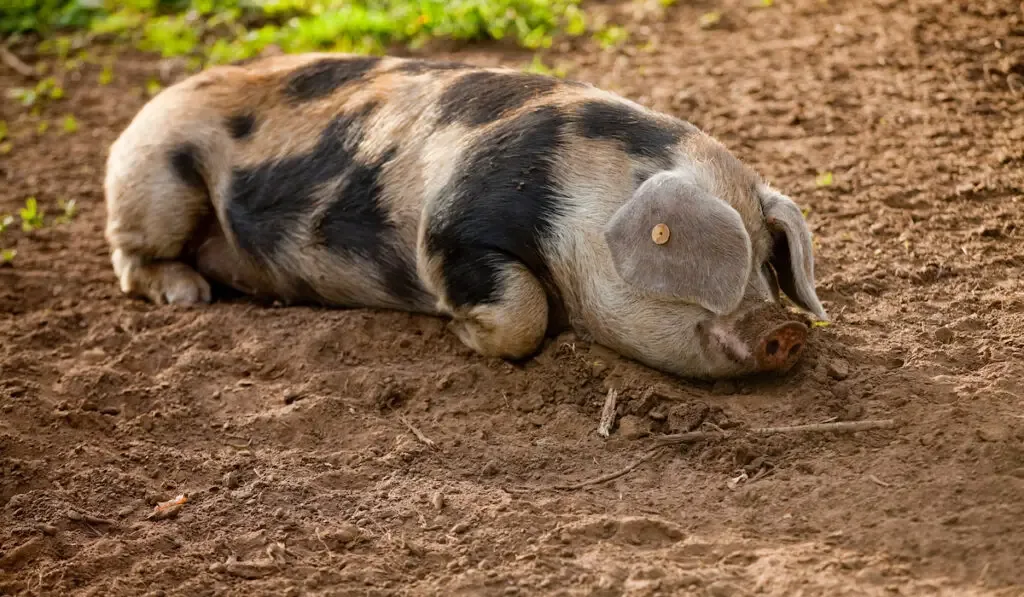
Also known as Schwarz-Wesses and Buntes Bentheimer Schwein, these rare and small domestic pigs are native to Bentheim, Germany. They were developed in the early 20th century from a cross between the Berkshires and the Cornwalls.
At maturity, they are 28 to 30 inches tall and weigh around 396 to 551 pounds.
Benthem Black Pied pigs can be recognized by their medium-sized bodies, looped ears, short legs, twisted tails, and uneven black spots with gray rings on their white bodies.
Aside from their docile temperament, they are also a hardy breed and able to thrive in cold climates. Today, these pigs are raised mainly for their rare and high-quality meat.
6. British Saddleback
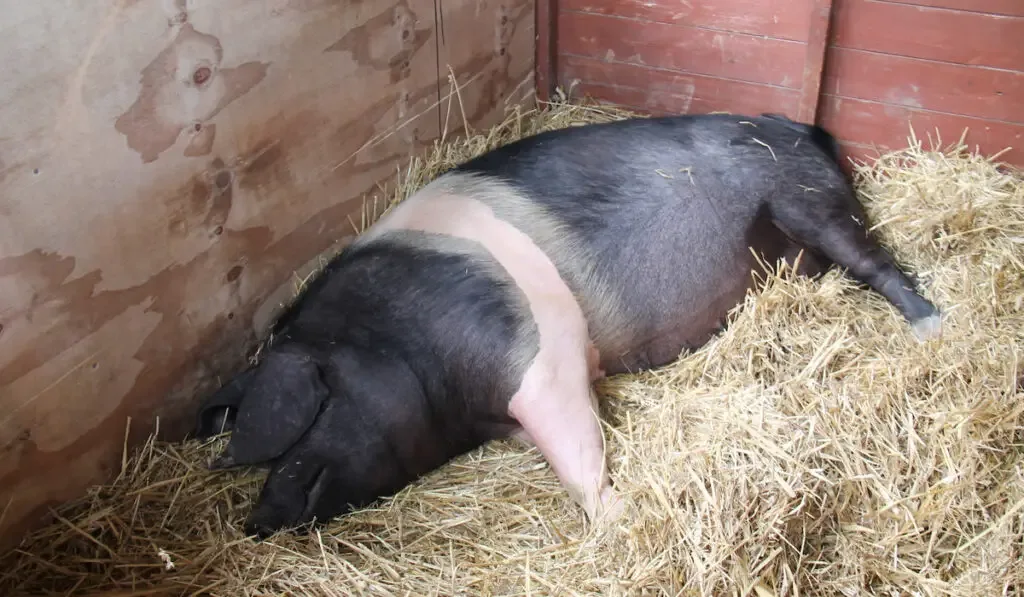
This modern British breed was developed in 1967 by crossing two traditional saddleback breeds, the Essex and the West Saddleback.
In 1954, when their population declined by almost 22% of the total, preventive measures were taken by cross-breeding saddleback sows with a white boar, producing pigs that can be used for both meat and bacon production.
Finally, this breed was listed as ‘endangered-maintained by FAO in 2007.
British Saddleback pigs have short heads, looped ears, large black bodies, and a white band or saddle around the shoulders, withers, and front legs. Some white coloration can also be found on their nose, hind feet, and tails.
At maturity, they are 33 to 36 inches tall and weigh around 595 to 705 pounds. Being a docile breed, they are easy to manage and able to feed themselves by actively foraging for food.
7. Essex
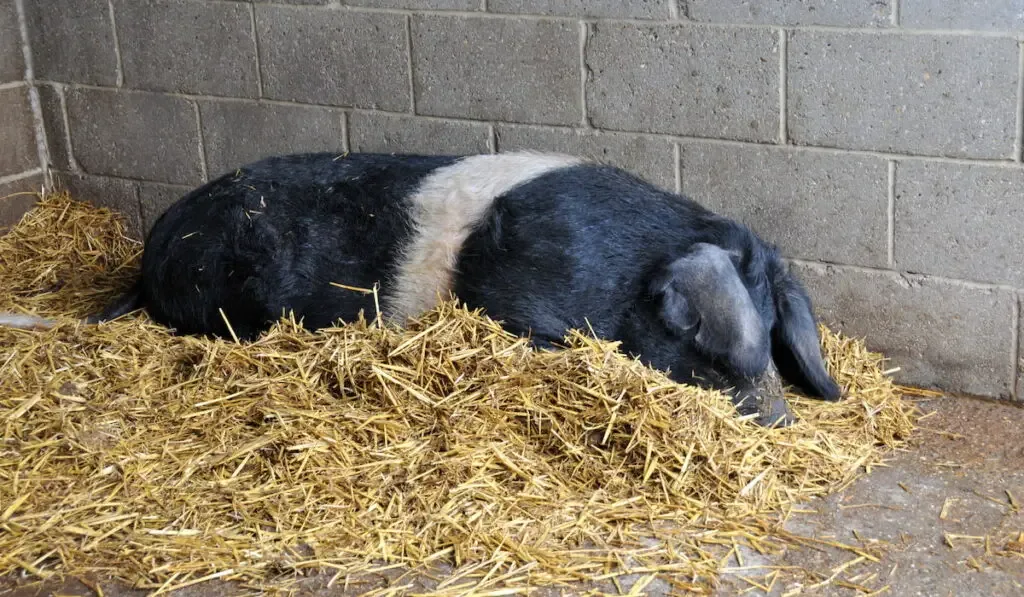
Like their name, these pigs are native to the county of Essex in the United Kingdom. Essex pigs were first developed through selective breeding of wild pigs. In the early 19th century, the traditional breed was crossed with Neapolitan pigs that were brought by Charles Western. Their population began to increase and the Essex Pig Society was founded in 1997.
Essex pigs have a narrow head, erect ears, short neck, black bodies, and a broad white band across their shoulder. At maturity, the sows weigh around 198 to 220 pounds and the boars weigh around 220 to 243 pounds.
These are calm, docile, and easy to grow on small farms. Some people also raised them as pets. Being excellent foragers, they are independent and able to feed themselves.
8. Gloucestershire Old Spots
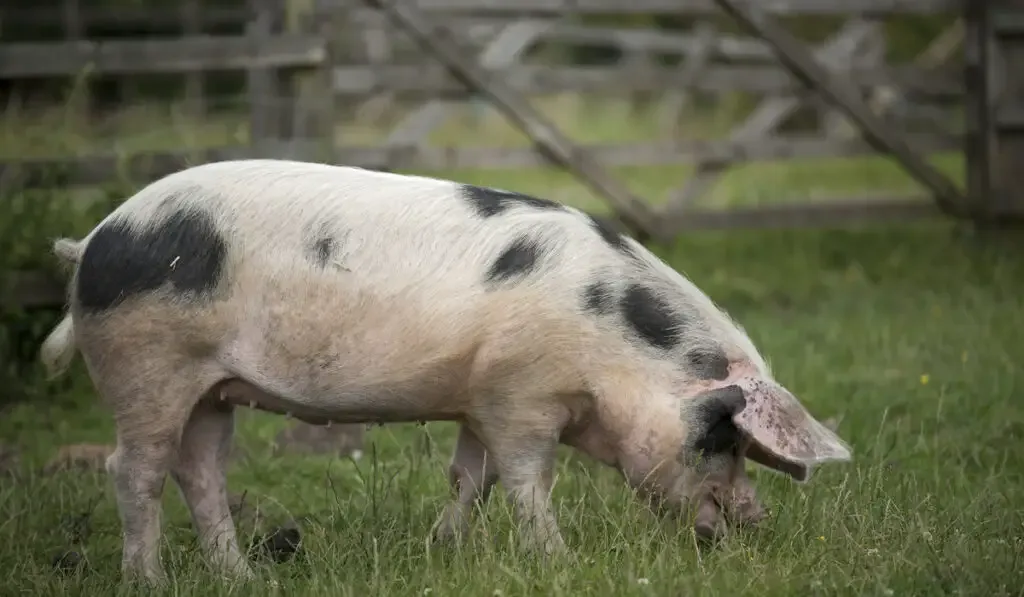
Also known as the Orchard pigs and the Cottager’s pigs, this breed was developed in the Berkley Vale of Gloucestershire, England, during the 1800s. In the 1900s, they were first imported to the United States and contributed to the development of several American breeds, specifically the Chester White and the American Spot.
Due to the decline in their population, The Gloucestershire Old Spots Pig Breeder’s Club was established in 1990 to preserve this breed from becoming extinct.
Gloucestershire Old Spots pigs have stocky and large bodies, short heads with slightly dished noses, looped ears, and black spots on their white coats. Mature sows generally weigh around 500 pounds while the boars are slightly heavier, around 600 pounds.
Aside from being hardy, these pigs are docile, intelligent, and able to forage independently for food. They are also able to thrive in an outside system without strict supervision.
9. Hampshire
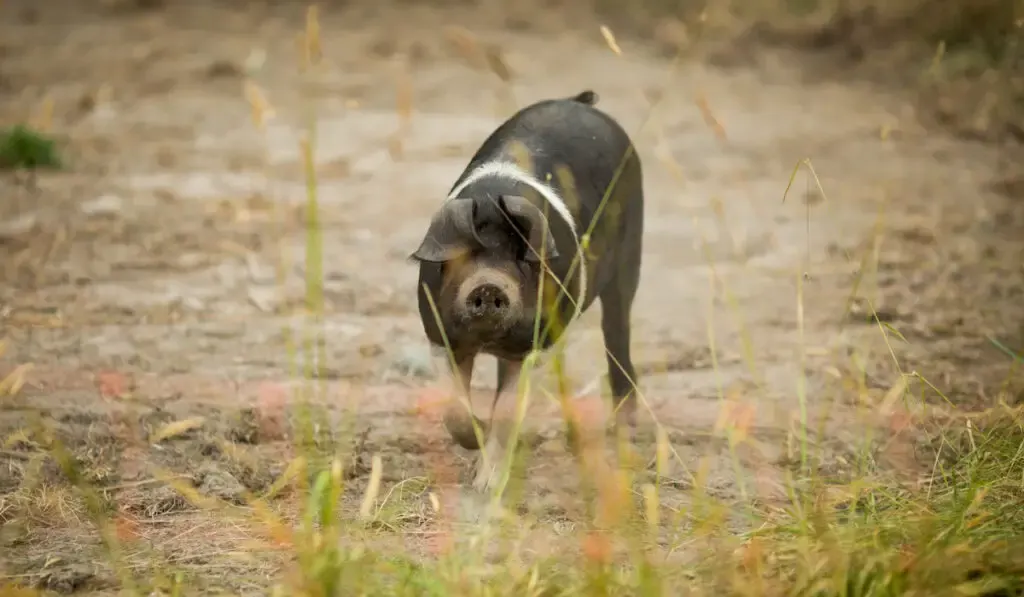
Hampshire pigs originated in southern Scotland and northern England. Named after their place of birth in Hampshire, United Kingdom, these pigs were first imported to the United States in the 1830s. Some also called them McKay hogs after the person who brought them to the United States.
Several other names came up for these pigs including the McGee, the Saddleback, and the Ring Middle. Finally, in 1904, the name was standardized to just one name by the American Hampshire Record Association.
Hampshire pigs are medium to large-sized hogs with black coats and a distinctive white belt or band around the shoulders.
At maturity, the sows weigh up to 550 pounds while the boars weigh around 650 pounds. These pigs are generally docile and friendly. However, they can be emotional and hostile when they are not in a good mood.
Due to their size, Hampshire pigs are raised for the quality of their meat.
10. Idaho Pasture
Developed by Gery and Shally Ferris in Idaho, these medium-sized pigs are also known by their other names: the Pasture Pork, the Natural Pork, the Grass Fed Pork, and the Grazing Pig. Idaho Pasture pigs were created from a mix of three different breeds: Old Berkshire, Duroc, and the Kune Kune.
At maturity, the sows weigh 250 to 350 pounds and the boars weigh 350 to 450 pounds.
Idaho Pastures can be recognized from their erect ears, wide snouts, medium-sized bodies, and coats that come in different shapes and colors of black and white, brown and black, or ginger and cream.
They are docile and get along well with humans, making them one of the best choices for people with small farms. These pigs are able to adapt to different climates change and mainly feed on grasses or plants.
11. Jinhua
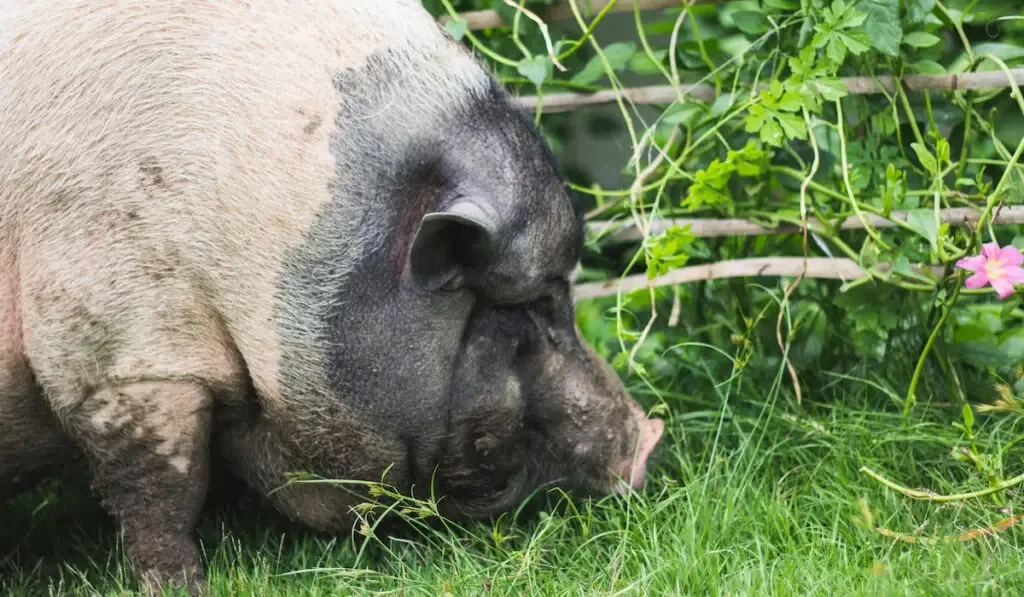
Jinhua pigs are native to Zhejiang Province in Central China. These medium-sized pigs possess white bodies and black coloration on their heads and rumps. This color pattern is also called the two-black-end.
Jinhuas thrive in a warm and moist environment between the Yangtze and Zhu Jiang Rivers. These regions are filled with grasses and water plants that become their main source of food.
These pigs mature early and are able to breed when they reach 3 or 4 months old. Each sow can give birth to thirteen per litter. Healthy sows can live up to 8 or 9 years, producing around 20 herds of pigs. Jinhua pigs are a hardy breed and thrive in different climates or temperatures.
They have a high international reputation for their good meat, mostly in Japan, Canada, France, Thailand, and China.
12. Krskopolje
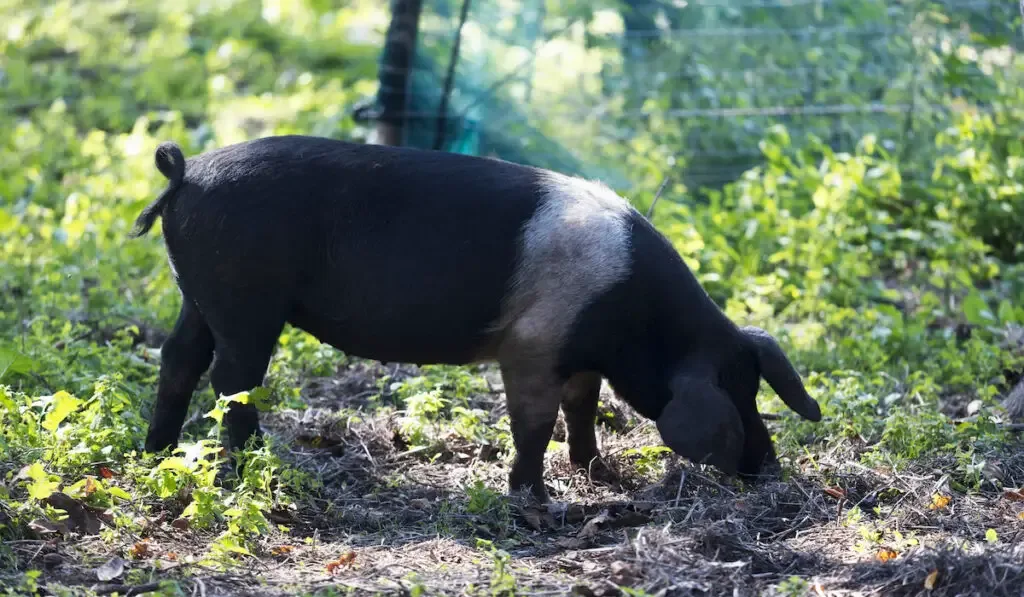
Also known as black-belted pigs, Krskopoljes originated from the Carniola and Styla regions of Slovenia. These medium to large-sized pigs have a medium-sized head, looped ears, white forelegs, black bodies, and continuous white belts or bands over their shoulders.
At maturity, these pigs weigh 551 to 661 pounds.
Krskopoljes are well-known for the quality of their meat and fats. However, due to their low productivity rate, cases of inbreeding occur frequently. These pigs are easy to handle and resistant to many diseases.
The sows are good mothers and able to produce between 8 to 10 piglets during their breeding life. These pigs are commercially raised for the production of pork, sausages, and ham.
13. Lithuanian Native
Lithuanian Native pigs come from a landrace breed of domestic pigs that are native to Lithuania. These medium-sized pigs are one of the oldest pigs to hail from Europe and were used extensively to produce the Lithuanian white and other Russian breeds.
Due to the decline in their population, the Lithuanian Institute of Animal Science was founded in 1994 to prevent this breed from becoming extinct.
Lithuania Native pigs have a medium-long body, thick skin, long bristles, and large black spots on their bodies. Their color comes in different variations ranging from black and white, tri-colored, ginger, white, and black.
At maturity, these pigs measure 30 to 35 inches tall and weigh 397 to 573 pounds. Being a hardy breed, they are fairly docile and able to thrive in harsh climates and outside systems.
14. Bisaro
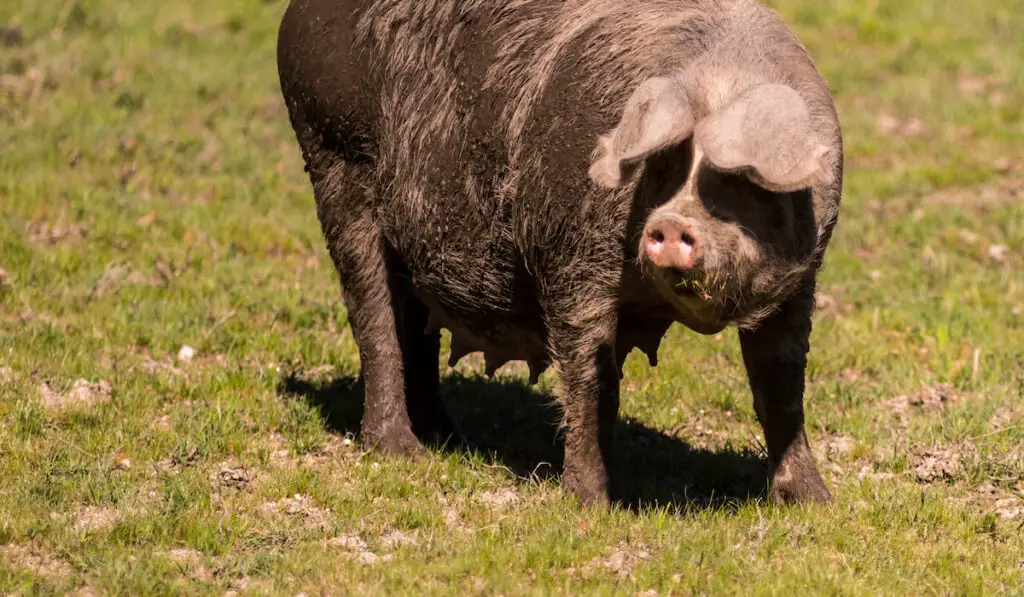
As one of the domestic pigs that can be commonly found in Portugal, Bisaro pigs are also known as the “Porco Bisaro” or “Celta” by the locals. They are specifically from the regions of Minho, Beira, Tras-os-Montes, and Alto-Douro.
In the 19th century, J.F. Macedo Pinto categorized this breed as Bizaro Type I or Celtic that comes from the variation of Celtic pigs from Gaul.
Bisaro pigs have medium-sized bodies, drooping ears, convex back, and black or white spots. They are docile and can be clumsy or slow, depending on their moods.
Nowadays, Bisaros are raised in a semi-extensive system. These pigs feed on various types of food such as fruits, tubers, plants, and cereals.
Their meat can be commercially produced into high-quality bacon, sausages, and hams.
15. Mong Cai
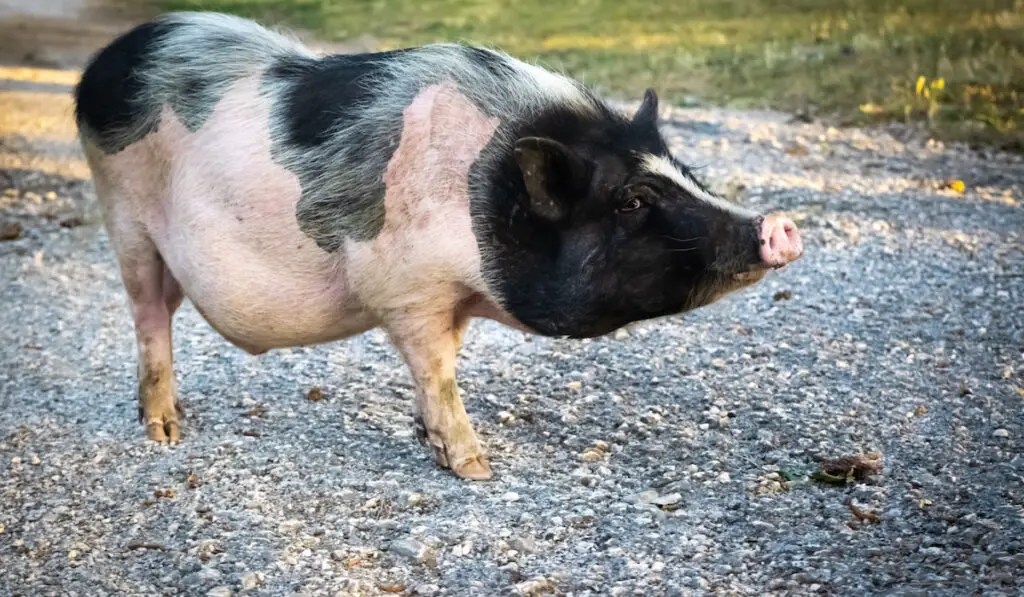
The Mong Cai pigs originated from northern Vietnam, specifically in the region of the Red River delta, provinces of North Mountain, and in the northern part of Central Coastline.
These small to medium-sized pigs have black heads, erect ears, black patches, and a white band that extends from their shoulders through the abdomen.
Mong Cai pigs mature as early as 2 or 3 months. When they reach 12 months, they weigh up to 132 pounds with a backfat thickness of 2.1 to 2.3 inches. These pigs are hardy and poor feeders.
They grow quickly and thrive on a simple diet such as roughage, farm wastes, fresh duckweed, and ensiled cassava foliages. The sows are also good mothers and able to produce around 10 to 12 litter.
16. Myrhorod
Also known as Mirgorods, this breed is a lard-type pig breed that originated from Ukraine. They were developed from a cross of local black-ruffled pigs with medium white, Berkshire, Temvorskaya, large black, and partially large white pigs.
At maturity, the boars are around 71 inches long and weigh around 639 pounds, while the sows measure around 64 inches long and weigh around 518 pounds.
Myrhorod pigs have medium-sized heads, medium-length snouts, short and erect ears, wide bodies, black or rusty irregular patches, and a white belt or band over their shoulders that extends to the forelegs. They also have long, shiny bristles with elastic skin.
17. North Caucasian
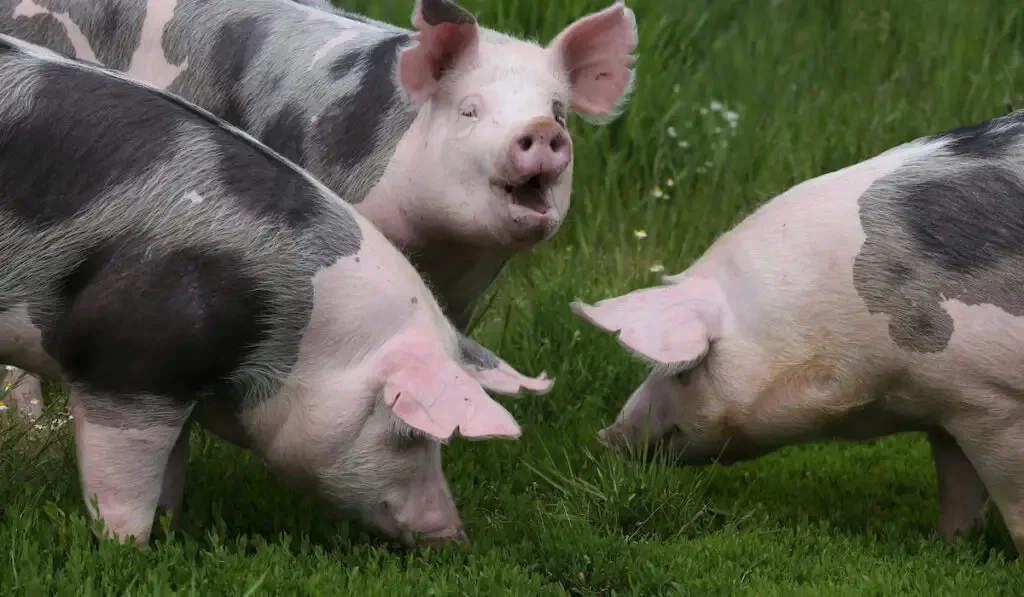
North Caucasian pigs hail from Russia and Uzbekistan and were primarily raised as general-purpose pigs. They were developed from a cross of local Kuban pigs with a few other breeds such as white-short, Berkshire, large white pigs.
At maturity, the boars weigh 661 to 771 pounds and measure around 70 inches long, while the sows weigh around 529 pounds and measure around 63 inches long.
These pigs have wide heads, stocky bodies, erect ears, deep chests, strong feet, and black and white bodies that grow a soft undercoat during the winter.
The sows are good mothers and able to produce litters with a size of 10 to 11 pigs. Plus, they are more docile and friendly compared to the boars.
In 1955, this breed was approved as an independent breed to be used in the production of meat and fats.
18. Pietrain
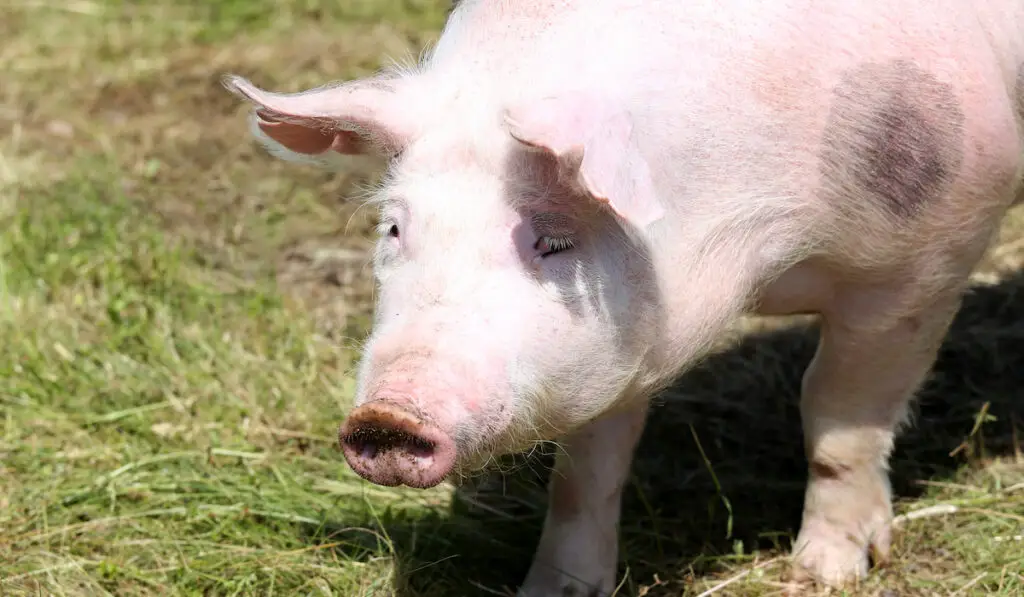
Formerly known as the British Blue and Belgium blue, this pig breed was named after a village in Belgium where they became popular and were exported to other countries such as Germany.
In the 1940s, they were imported to the United Kingdom under British government order, to be used in the production of modern pig breeds with high-quality meat. Then, their popularity increased and they became well-known in other parts of the world.
Pietrain pigs are medium-sized with erect ears, long snouts, short legs, and black spots with rings of light pigmentation on their white bodies. These spots or patterns are also called the piebald markings.
At maturity, the sows weigh 485 to 530 pounds and the boars weigh 530 to 570 pounds. Unlike other pig breeds, they are fairly clean and intelligent.
Aside from being omnivores, they also can drink between 10 to 14 gallons of water per day.
19. Wessex Saddleback

Wessex Saddleback pigs are native to the region of the New Forest and Wiltshire in southern England. This breed was created in 1967 from the amalgamation of two similar breeds, the Essex and Wessex saddleback. Then, in 1918, The Wessex Saddleback Breed Society was founded in Britain.
Preventive measures were taken to preserve this breed when their population declined after the start of extensive breeding systems and intensive pig farming in the 20th century.
At maturity, Wessex Saddlebacks measure 33 to 36 inches tall and weigh 661 to 771 pounds. These pigs have white feet, black bodies, and a distinctive white belt or band on their shoulders that extend to the forelegs. Wessex Saddlebacks are docile and easy to handle.
Being a hardy breed, they can thrive in outdoor systems and are able to forage independently without strict supervision. These pigs are raised mainly for the production of bacon and hams.
Final Thoughts
All of these pig breeds have different needs, temperaments, and environments they can optimally live in.
No matter which breed they are, most of them are essential to the production of commercial meat.
As long as humans can sustainably breed and raise these animals, there will always be a demand for pigs’ meat.
Citations
Angeln Saddleback
- https://www.thepigsite.com/breeds/angeln-saddleback
- https://www.breedslist.com/angeln-saddleback.htm
Aksai Black Pied
- https://agricfarming.com/facts-on-aksai-black-pied-pig-breed/
- https://www.breedslist.com/aksai-black-pied-pig.htm
Ba Xuyen
- https://www.thepigsite.com/focus/advertiser/4461/the-different-breeds-of-swine-ba-xuyen-ba-xuyen-pig-breed-ba-xuyen-gilts-sows-and-boars
- https://www.livestockoftheworld.com/pigs/Breeds.asp?ScreenWidth=1366&speciesID=12&BreedlookupID=1780
Belarus Black Pied
- http://afs.okstate.edu/breeds/swine/belarusblackpied/index.html/
- http://knowledgebase.lookseek.com/Belarus-Black-Pied-Pig.html
Bentheim Black Pied
- http://www.livestockoftheworld.com/Pigs/Breeds.asp?BreedLookupID=1788&SpeciesID=12
- https://www.thepigsite.com/breeds/bentheim-black-pied
British Saddleback
- https://www.rbst.org.uk/british-saddleback
- https://livestockconservancy.org/index.php/heritage/internal/saddleback
Essex
- https://farmingcafe.com/essex-pig/
- https://www.livestockoftheworld.com/pigs/Breeds.asp?BreedLookupID=1811&SpeciesID=12
Gloucestershire Old Spots
- https://livestockconservancy.org/index.php/heritage/internal/gos
- https://www.thepigsite.com/focus/advertiser/3657/the-different-breeds-of-swine-gloucestershire-old-spot-gloucestershire-old-spot-pig-breed-gos-gilts-sows-and-boars
Hampshire
- https://agro4africa.com/hampshire-pig-breed/
- https://nationalswine.com/about/breeds/about-hampshire.php
Idaho Pasture
- https://idahopasturepigregistry.com/breed-standard/
- https://www.iamcountryside.com/pigs/raising-idaho-pasture-pigs/
Jinhua
Krskopolje
- https://www.fondazioneslowfood.com/en/ark-of-taste-slow-food/krskopolje-pig/
- https://www.thepigsite.com/breeds/kr%C5%A1kopolje
Lithuanian Native
- http://afs.okstate.edu/breeds/swine/lithuaniannative/index.html/
- https://www.thepigsite.com/breeds/lithuanian-native
Bisaro
- http://www.livestockoftheworld.com/Pigs/Breeds.asp?ScreenWidth=1366&speciesID=12&BreedlookupID=1790
- https://www.thepigsite.com/articles/the-indigenous-portuguese-bsaro-pig
Mong Cai
- http://knowledgebase.lookseek.com/Mong-Cai-Pig.html
- http://afs.okstate.edu/breeds/swine/mongcai/index.html/
Myrhorod
- https://www.nativebreed.org/myrhorod-pig/
- http://www.livestockoftheworld.com/pigs/Breeds.asp?ScreenWidth=1366&speciesID=12&BreedlookupID=1859
North Caucasian
- https://www.livestockoftheworld.com/pigs/Breeds.asp?ScreenWidth=1366&speciesID=12&BreedlookupID=1862
- https://geomedia.top/north-caucasian-pig/
Pietrain
Wessex Saddleback

